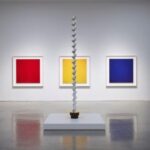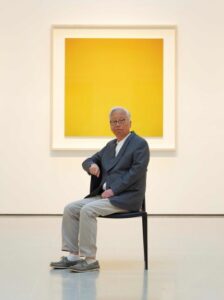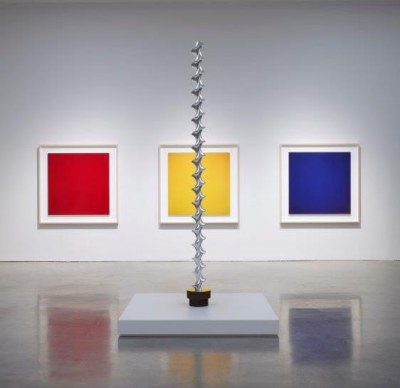 ‘I always think of the camera as a kind of time machine, I’m not looking to the future, I’m looking to the past, going back to study the origins of human beings and human civilisation. I want to ride in a time machine to go back and see the beginning.’
‘I always think of the camera as a kind of time machine, I’m not looking to the future, I’m looking to the past, going back to study the origins of human beings and human civilisation. I want to ride in a time machine to go back and see the beginning.’
– Hiroshi Sugimoto
[2 August 2024, Sydney], The Museum of Contemporary Art Australia (MCA Australia) today opens Hiroshi Sugimoto: Time Machine, the first survey of the internationally renowned artist’s work to be presented in Australia. The exhibition brings together close to 100 of the artist’s most important works dating from the 1970s through to the present day.
Over the last 50 years, Japanese photographer Hiroshi Sugimoto (b. Tokyo, 1948) has created some of the most celebrated and recognisable images in contemporary art. Hiroshi Sugimoto: Time Machine highlights the artist’s philosophical yet playful inquiry into time and memory, and photography’s ability to both document and invent.

‘In images that transfix and mystify, the great Japanese photographer Hiroshi Sugimoto seems to conjure a dream state outside of time and place in this magnificent first retrospective. This is a beautiful, enthralling and meditative show.’
– Laura Cumming, The Observer
Chronicling five decades of the influential artist’s practice, Hiroshi Sugimoto: Time Machine encompasses works from all of the artist’s major photographic series and includes rarely-seen pieces from the photographer’s own collection alongside works from the Odawara Art Foundation in Japan.
Sugimoto’s approach to photography has stretched and reshaped our ideas about how photographs record time, light and space. For Sugimoto, photography is uniquely suited for preserving and picturing time’s passage, functioning as a form of time machine. Through images that unsettle and inspire, he has transformed traditional photographic genres such as still life, landscape, portraiture and abstraction to open new perspectives on how we understand history, nature, art and existence itself.
The history of photography is embedded in Sugimoto’s use of the photograph as the bearer of ideas. Throughout his career the artist has revisited Concepts and practices from 19th-century photography. Meticulous in his craft, he frequently works with an old-fashioned wooden view camera and mixes his own darkroom chemicals. Inspired by experiments and subjects from the early history of photography he has captured a range of subjects related to science and mathematics as well as painting and architecture.
Hiroshi Sugimoto: Time Machine has been developed through an international partnership between the MCA Australia, Hayward Gallery, London and UCCA Center for Contemporary Art, Beijing. The original London presentation was curated by Hayward Gallery Director, Ralph Rugoff. The exhibition at the MCA Australia is curated by MCA Australia Curator Megan Robson and MCA Australia Director of Curatorial & Digital Lara Strongman.
Suzanne Cotter, Museum of Contemporary Art Australia Director said, ‘Sugimoto is one of the world’s preeminent living artists whose remarkable art has entered into the public consciousness as part of our visual lexicon. The MCA could not be more honoured and excited to be presenting his work in this extraordinary retrospective survey which will inspire and delight in its visual and meditative richness. His is truly an art for now.’
Ralph Rugoff, Hayward Gallery Director said, ’Hiroshi Sugimoto is constantly playing with the fact that photography is a medium that lends itself both to documenting, but also to invention. No-one has ever made photographs like these.’
The NSW Minister for the Arts and Minister for Jobs and Tourism, John Graham said, ‘I’m so excited to open the Time Machine exhibition. This exhibition will be incredible for the gallery and its visitors, but also the surrounding area in The Rocks and the CBD. It’s exactly what we want to see, our landmark cultural institutions inspiring our creative communities, attracting visitors and driving vibrancy and revenue for local businesses.’
Exhibition highlights
One of the artist’s best-known series of photographs, Dioramas (1976–2012) was begun shortly after Hiroshi Sugimoto arrived in New York in 1974. In these large-scale black-and-white photographs, the artist uses the camera to transform the famous dioramas of the natural world in the American Museum of Natural History into seemingly ‘real’ scenes. The series of images marked for Sugimoto the beginning of his ‘life as an artist’.
Sugimoto’s Portraits (1999), like Dioramas, question the camera’s truth telling capacity. Begun in 1994, Portraits depicts royalty, politicians, writers and artists over a period of 500 years. Focusing his camera on the wax models at Madame Tussauds in London, Sugimoto’s photographs bring back to life famous figures such as Oscar Wilde, Princess Diana, Anne Boleyn and Salvador Dalí. Reflecting on the ability for the photograph to deceive the viewer, Sugimoto has observed that ‘however fake the subject, once photographed, it’s as good as real.’
Time is a key exploration throughout the artist’s practice and is eloquently considered in two of Sugimoto’s most iconic series of photographs, Theaters (1976–ongoing) and Seascapes (1980–ongoing). Seascapes has become a ‘lifetime project’ for the artist. The meditative images depict atmospheric expanses of ocean and sky captured at day or night and in multiple locations including Australia, Italy, Japan and the UK. Devoid of any visual distractions and focusing on the interaction of water, air and the light of the sun, the photographs evoke a time before humanity’s influence on the natural world.
In Theaters the artist has used long exposures to capture a full-length film in a single photographic take. ‘To watch a two-hour movie,’ Sugimoto reflects, ‘is simply to look at 172,800 photographic afterimages.’ The dramatic action of a motion picture is condensed into a single, glowing projection screen which illuminates the interiors of classic theatres, historic cinemas and ornate opera houses across the globe.
Sugimoto’s interest in art and its intersections with religion and science is considered in works such as Sea of Buddha (1995) and Lightning Fields (2006–ongoing). The Sea of Buddha series portrays Sanjūsangen-dō, a 12th-century Buddhist temple in Kyoto. Sugimoto photographed the 1001 gilded wooden statues of Kannon, bodhisattva of compassion, installed in the worship hall at sunrise over 10 days, just as the first rays of light filtered through the historic building.
In Lightning Fields, Sugimoto experiments with camera-less photography to produce dramatic images created by exposing photographic film to electrical currents produced by a Van de Graaff 400,000-volt generator.
The exhibition will present Sugimoto’s most recent series of photographs, Opticks (2018-ongoing), inspired by Isaac Newton’s pivotal investigations in the 17th century, which proved that natural light was not purely white but comprised of multiple colours. The vivid colour photographs of prism-refracted light are the result of almost a decade of experimentation and are described by the artist as ‘a new kind of painting’.
Public Engagement Programs
To celebrate the opening of Time Machine, the MCA Australia will host Up Late: Hiroshi Sugimoto an evening of dedicated events including poetry readings by award-winning writer Brook Emery and a Body Weather performance by dancer and choreographer Victoria Hunt, from 5–9pm on the 2 August.
A special in-conversation between Hiroshi Sugimoto and exhibition co-curator, Lara Strongman, Director of Curatorial and Digital, will also take place at 6pm on the 2 August.
The MCA Australia has commissioned sound artist Ai Yamamoto to create a pair of soundscapes to be enjoyed by visitors in the exhibition space. Yamamoto’s atmospheric compositions directly respond to Sugimoto’s Seascapes, Opticks and Mathematical Models series of works.
Family Space: Light Lab will offer free hands-on artmaking activities inspired by Hiroshi Sugimoto’s Opticks series of photographs, on weekends throughout the exhibition and every day during school holidays (28 September – 13 October).
Taking place every weekend in the exhibition galleries, visitors can enjoy a series of talks, music performances, poetry readings, activities and experiences responding to Sugimoto’s artworks.
Visitors to the exhibition will also be able to access a range of digital resources about the exhibition including information on the artist, video interviews, and all-ages activities.
Visit go.mca.com.au/TimeMachine for more information.
Plan your Sydney trip at sydney.com
Publication
A fully illustrated 216pp catalogue has been published on the occasion of the exhibition with newly commissioned essays by international writers, artists and scholars – including Geoffrey Batchen, Edmund de Waal, Mami Kataoka, Ralph Rugoff, Margaret Wertheim and Lara Strongman and a comprehensive chronology. The catalogue is co-published by Museum of Contemporary Art Australia, Hayward Gallery, London, and UCCA Center for Contemporary Art, with Hatje Cantz and is available to purchase from the MCA Store and online.

About the Artist
Hiroshi Sugimoto was born in Tokyo, Japan in 1948. He graduated from Saint Paul’s University, Tokyo, in 1970 and from the Art Center College of Design, Los Angeles, in 1974. He moved to New York the same year. He currently splits his time between Tokyo and New York.
Sugimoto’s photographs are in the collections of prominent museums around the world, including the Metropolitan Museum of Art, New York; Museum of Modern Art, New York; National Gallery of Art, Washington, DC; National Gallery of Canada, Ottawa; National Museum of Modern Art, Tokyo; San Francisco Museum of Modern Art; Tate Gallery, London; and many more.
Acknowledgements
The exhibition is organised by the Hayward Gallery, London in association with MCA Australia and supported by the NSW Government through its tourism and major events agency Destination NSW.
Hiroshi Sugimoto: Time Machine is the Museum of Contemporary Art Australia’s (MCA Australia) major winter exhibition and runs from 2 August until 27 October 2024.




















